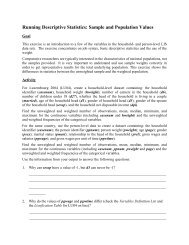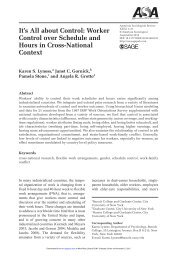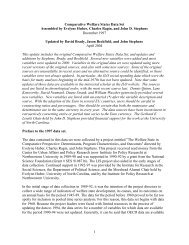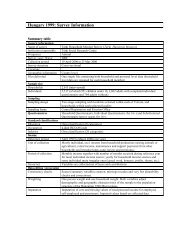Nicola Dickmann: - LIS
Nicola Dickmann: - LIS
Nicola Dickmann: - LIS
You also want an ePaper? Increase the reach of your titles
YUMPU automatically turns print PDFs into web optimized ePapers that Google loves.
question, the level of childless women seems to be a good indicator for the relevantfamily phase. At the age of 30, the group of childless women, measured by the mean ofall countries, descends for the first time under the level of any other group with one ormore children. At the age of 43 it takes the lead again. The study therefore comparesthe relevant data of couples with the spouse being between the age of 30 and 42. Thesample is restricted to married couples in order to explore the economic situation of twoadults living with or without children. Hence, the often severe economic problems of lonemothers are ignored in this study. This does not indicate any underestimation of thedimension of this problem, but shall not be the focus here.3 Income and fertilityAccording to the economic theory of fertility, couples decide rationally over the numberof children they want, taking the costs of raising children and their income situation intoaccount (Becker, 1960). A higher income should primarily provide a stimulus for couplesto have more children, being able to afford the costs of raising more children thancouples in worse financial conditions (known as the income effect). On the other hand,higher income leads to higher opportunity costs, provided that both parents contribute tothe family income and one has to give up paid work in order to spend time at home,raising the children. Furthermore, according to Becker, educated parents tend to investmore in the education of their children and are therefore facing higher costs of raisingchildren (substitutional effects). Which effect dominates the other has been debatedextensively in the context of the low fertility levels in industrialised countries. Quite often,researchers say that high income couples have fewer children than low income couples,therefore giving a priority to the substitutional effect (Schwarz, 1999). This phenomenonis known as the demographic paradox (Birg, 2001, p. 42ff). However, studies, providingempirical evidence for this are hard to find. In most cases, researchers quote the highlevels of childlessness among academic women as a prove or revert to themacroeconomic evidence that rich countries have lower fertility rates than poorcountries. But neither fact indicates the correlation of fertility and income based on theview of the deciding couples. The following study therefore takes a closer look at the4










